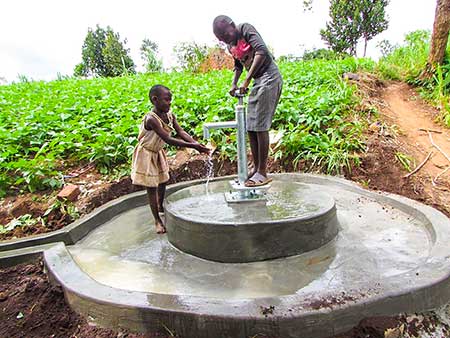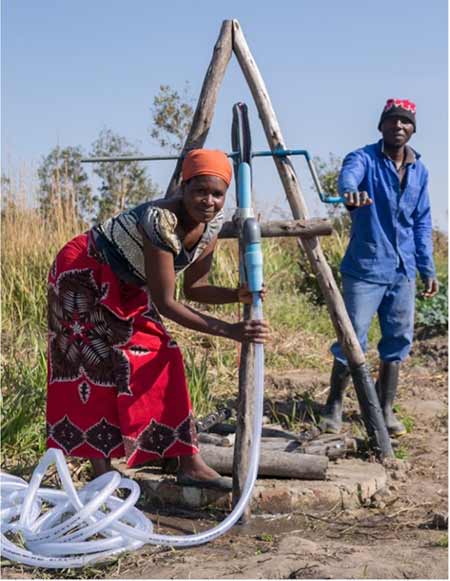
When Design Outreach, an Ohio-based nonprofit, visited the Chickwangwala village in Malawi in late 2020 to install a new pump, a local woman had died by crocodile attack while getting water from the river just a few days earlier. In fact, the village had just held a funeral for her the day before Design Outreach arrived.
“When the water first started flowing, people were celebrating and danciing and all sorts of things,” said Greg Bixler, co-founder and CEO of Design Outreach. “Fortunately, we can prevent a lot of those tragedies.”

Access to safe drinking water is a challenge for people all over the world. Environmental, financial and societal barriers can all stand in the way of getting water that is safe to drink and can often result in obstacles that those with running water might not even consider.
In 2019, one in three people did not have access to safe drinking water, according to the World Health Organization (WHO) and UNICEF. Unsafe drinking water can lead to the transmission of diseases like cholera, dysentery, hepatitis A, typhoid and polio, and treks to gather safe drinking water get in the way of daily life—interrupting school, work and family time.
Luckily, there are plenty of key players in the pumps industry who are dedicated to changing that.
Grundfos’ annual Walk for Water, which fundraises for nonprofit organization Water Mission, was held virtually last fall and helped raise roughly $175,000. Grundfos’ foundation, the Poul Due Jensen Foundation, also helps to improve access to safe drinking water worldwide through partnerships with other water organizations.
Xylem’s social responsibility program, Xylem Watermark, partners with nonprofits all over the world to improve education and protect safe water resources. Xylem recently partnered with the youth program Cityzens Giving for World Water Day in March to create The Water Heroes Academy, which will help 100 young leaders in five cities around the world create solutions for water problems in their hometowns.
Many organizations, like the aforementioned Design Outreach (DO), have gotten creative to solve the water crisis.
Typical hand pumps installed in developing countries are piston-style pumps made out of plastic or galvanized steel, which makes them cheap, easily breakable and quick to rust. When those pumps do break, spare parts—though inexpensive—are hard to get thanks to supply chain issues.
DO’s invention, the LifePump, is a progressive cavity pump designed to dig deeper (500 feet as opposed to the standard 150 feet) and last longer than a standard piston pump. Made of stainless steel, the pumps are created to last five years before any maintenance is needed.

There are currently 140 LifePumps installed in 10 countries, half of which have monitoring capabilities through a satellite-based sensor dubbed LifePump Link.
“It’s not just because people need water, it’s that they need knowledge that water will be there tomorrow,” said Bixler, who, along with DO’s other co-founder Abe Wright, has a background in mechanical engineering. “We felt that we were being led to use our engineering talents to help create better solutions where there is really no focus because there’s not an industry—there’s not money in it.”
Another pump-focused organization, Pump Aid, makes small-scale, low-cost pumps and sells them at a loss to people in Malawi. The organization also set up a system for maintaining and repairing the pumps installed already, giving local mechanics business and ensuring the installed pumps will keep working.
“Over the last five years, we’ve moved into doing more of the repair and maintenance and less of the installations because, theoretically, there are enough pumps in Malawi to serve the population,” said Duncan Marsh, director of programs for Pump Aid. “The problem is that a lot of them are breaking down.”
Pump Aid’s different approach—selling pumps to those in need rather than donating—comes from finding that when people pay for the pumps, they tend to last longer and run better than if the pump had been donated.
“We found that when people invest in something, they tend to look after it,” Marsh said. “We think injecting some financial reward into the provision of social goods isn’t a bad thing because we’ve been trying it without for 30 years and things have gotten worse. So, we need to incentivize the people and, clearly, people are incentivized by money.”
Over 20 years, engineering organization Water Mission has helped to provide safe water access to 7 million people in 57 countries with both long- and short-term results. “We’ll go into a community and look at what the needs are and then we’ll design a solution,” said CEO and President George C. Greene IV.
Long-term solutions can include everything from solar-powered pumping systems and wells to potable water chlorinators. Most projects center around community access points. “We’re looking to get 80% of the community within less than 100 yards of an access point,” Greene said.
Water Mission also provides more short-term help through disaster relief with its Living Water Treatment System (LWTS): a miniature, easy-to-transport water treatment plant capable of cleaning 10,000 gallons of water a day. The organization recently responded to the hurricanes in Honduras last November and the winter storm plumbing problems in Texas in February.

Just A Drop works in six countries, half of them in Africa, and offers a variety of solutions for improving access to safe drinking water, depending on what the environment demands: rainwater tanks, hand pumps, wells, dams, BioSand filters and water distribution systems. Organization members also train locals on how to repair and maintain solutions put in place.
The organization especially focuses on community-led projects. “We don’t tell the community what they need, they tell us,” said Brendan Hanlon, head of fundraising and communications at Just A Drop. “Community involvement leads to sustainability.”
Hanlon explained that access to water can change a life in many ways. For example, putting a rainwater harvesting tank onto a school means the children will attend more regularly because they’re not out collecting water or getting sick from drinking dirty water. They can concentrate better in class because they’re better fed since there’s more water for farming and cooking. Then, their exam performance improves.
“It transforms lives,” Hanlon said. “It’s a brilliant thing to see, and I feel very privileged to play a role in that.”

